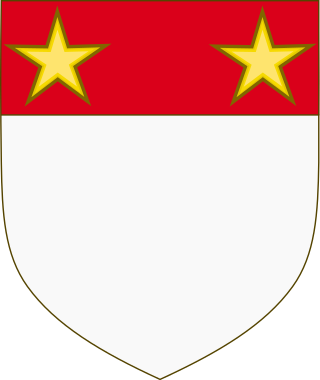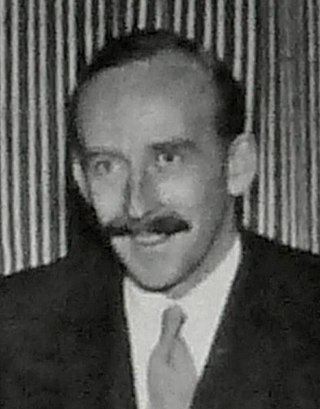
Baron FitzWalter is an ancient title in the Peerage of England. It was created on 24 June 1295 for Robert FitzWalter. The title was created by writ, which means that it can descend through both male and female lines.

Baron St John of Bletso, in the County of Bedford, is a title in the Peerage of England. It was created in 1582 for Oliver St John.

Baron Saye and Sele is a title in the Peerage of England held by the Twisleton-Wykeham-Fiennes family. The title dates to 1447 but it was recreated in 1603. Confusion over the details of the 15th-century title has led to conflicting order for titleholders; authorities such as Burke's Peerage and Debrett's Peerage do not agree on whether or not the 1447 creation is still extant.
Baron Ravensworth, of Ravensworth Castle in the County Palatine of Durham and of Eslington Park in the County of Northumberland, is a title in the Peerage of the United Kingdom.
Baron Wrottesley, of Wrottesley in the County of Stafford, is a title in the Peerage of the United Kingdom. It was created on 11 July 1838 for Sir John Wrottesley, 9th Baronet. He was a Major-General in the Army and also represented Lichfield, Staffordshire and Staffordshire South in House of Commons. The Wrottesley family's original patronymic was 'de Verdun', which meant that the creation of the title Baron Wrottesley represented the third barony created by a branch of the de Verdun family in England. The other two were established by Theobald de Verdun, 1st Baron Verdun of Alton Castle and Sir John de Verdon, 1st Baron Verdon, lord of Brixworth in Northamptonshire and Bressingham in Norfolk.
Baron Boteler was a title that was created three times in the Peerage of England.
The Ashburnham Baronetcy, of Broomham in the County of Sussex, is a title in the Baronetage of England. It was created on 15 May 1661 for Denny Ashburnham, Member of Parliament for Hastings. He was the grandson of Adam Ashburnham, Member of Parliament for Winchelsea in 1592, who was the son of Laurence Ashburnham, and a descendant of Richard Ashburnham of Broomham, second son of Thomas Ashburnham, whose eldest son John was the ancestor of the Earls of Ashburnham. He was succeeded by his elder son, William, the second Baronet. He represented Hastings and Seaford in the House of Commons. He died childless in 1755 and was succeeded by his younger brother, Charles, the third Baronet. His son, William, the fourth Baronet, was Bishop of Chichester. On his death the title passed to his son, the fifth Baronet. He sat as Member of Parliament for Hastings.
This is a list of Sheriffs of Norfolk and Suffolk. The Sheriff is the oldest secular office under the Crown and is appointed annually by the Crown. He was originally the principal law enforcement officer in the county and presided at the Assizes and other important county meetings. After 1576 there was a separate Sheriff of Norfolk and Sheriff of Suffolk.

Otto de Grandson, sometimes numbered Otto I to distinguish him from later members of his family with the same name, was the most prominent of the Savoyard knights in the service of King Edward I of England, to whom he was the closest personal friend and many of whose interests he shared.

The Bedingfeld, later Paston-Bedingfeld Baronetcy, of Oxburgh in the County of Norfolk, is a title in the Baronetage of England. It was created by Charles II of England in recompense for the family's losses in the Royalist cause during the Civil War and Interregnum years. The Bedingfelds are said to descend from 'Ogerlis', a Norman, who, in 1100, held land at Bedingfield, Suffolk. His descendant, Edmund Bedingfeld, married Margaret, daughter and heiress of Sir Robert Tuddenham, bringing to her husband estates including the manor of Oxburgh, near Swaffham, Norfolk.

Sir Edmund George Felix Paston-Bedingfeld, 9th Baronet was a landowner and British Army officer.

Grandson Castle is a medieval castle in the Swiss municipality of Grandson in the canton of Vaud. It is a Swiss heritage site of national significance.
General Edward Charles John Stopford Claremont CB was a British soldier who was the United Kingdom's first military attaché, holding the post in Paris for 25 years.

Pierre de Champvent was a noble originally from Savoy who made a career as a military and courtier in England.
Henri de Grandson was the son of Pierre I de Grandson and Agnes, a younger brother of the important friend and envoy of King Edward I of England, Otto de Grandson. Like his cousin Guillaume de Champvent and relative Gérard of Vuippens he pursued a church and diplomatic career in England before becoming taking up an important bishopric within the Holy Roman Empire.
Sir Henry Bedingfeld, 1st Baronet was a landowner and baronet.

Sir Henry Arundell Bedingfeld, 3rd Baronet, was an English landowner and baronet.
Sir Richard Bedingfeld, 5th Baronet, was an English landowner and baronet.
Sir Henry Richard Paston-Bedingfeld, 6th Baronet JP DL, was an English landowner and baronet.

Sir Henry George Paston-Bedingfeld, 7th Baronet DL was an English landowner.












